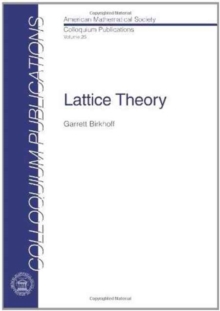
Frobenius Manifolds, Quantum Cohomology and Moduli Spaces Hardback
Part of the Colloquium Publications series
Hardback
Description
This is the first monograph dedicated to the systematic exposition of the whole variety of topics related to quantum cohomology.
The subject first originated in theoretical physics (quantum string theory) and has continued to develop extensively over the last decade.
The author's approach to quantum cohomology is based on the notion of the Frobenius manifold.
The first part of the book is devoted to this notion and its extensive interconnections with algebraic formalism of operads, differential equations, perturbations, and geometry.
In the second part of the book, the author describes the construction of quantum cohomology and reviews the algebraic geometry mechanisms involved in this construction (intersection and deformation theory of Deligne-Artin and Mumford stacks).Yuri Manin is currently the director of the Max-Planck-Institut fur Mathematik in Bonn, Germany.
He has authored and coauthored 10 monographs and almost 200 research articles in algebraic geometry, number theory, mathematical physics, history of culture, and psycholinguistics.
Manin's books, such as ""Cubic Forms: Algebra, Geometry, and Arithmetic"" (1974), ""A Course in Mathematical Logic"" (1977), ""Gauge Field Theory and Complex Geometry"" (1988), ""Elementary Particles: Mathematics, Physics and Philosophy"" (1989, with I.
Yu. Kobzarev), ""Topics in Non-commutative Geometry"" (1991), and ""Methods of Homological Algebra"" (1996, with S.
I. Gelfand), secured for him solid recognition as an excellent expositor.
Undoubtedly the present book will serve mathematicians for many years to come.
Information
-
Available to Order - This title is available to order, with delivery expected within 2 weeks
- Format:Hardback
- Pages:297 pages
- Publisher:American Mathematical Society
- Publication Date:30/07/1999
- Category:
- ISBN:9780821819173
Information
-
Available to Order - This title is available to order, with delivery expected within 2 weeks
- Format:Hardback
- Pages:297 pages
- Publisher:American Mathematical Society
- Publication Date:30/07/1999
- Category:
- ISBN:9780821819173










